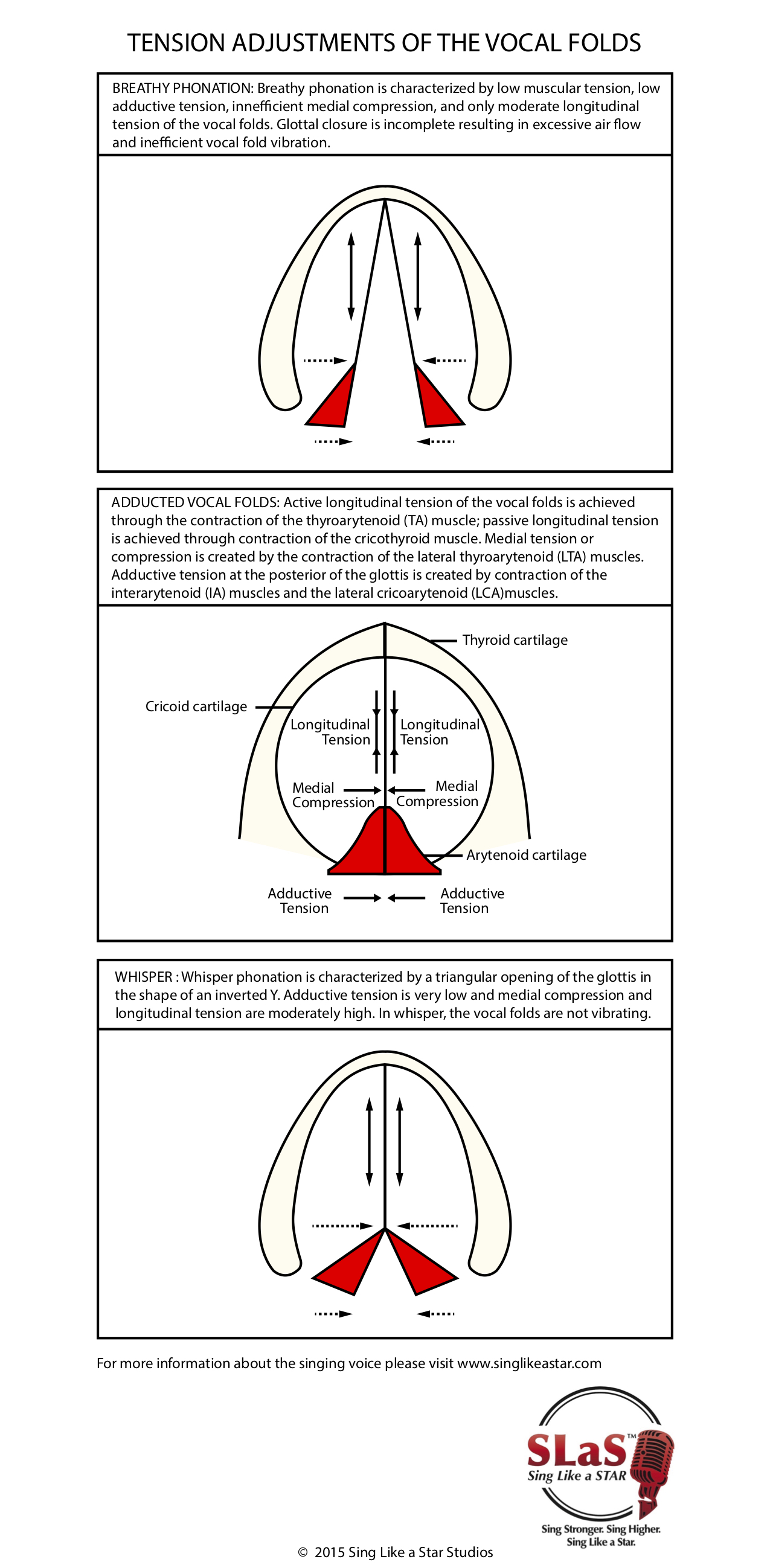Singing with Balance: The Balanced Onset

PARAMETER SIX: BALANCED ONSET
The manner in which the vocal tone is initiated determines the subsequent quality of the tone. Firm glottal closure at the onset of tone is necessary for efficient tone production.
The breathy abducted onset produces a weak and breathy tone. The hard attack can produce pressed phonation if combined with excessive air pressure. A balanced onset produces good chiaroscuro and healthy phonation.
The folds must be brought together to the midline of the glottis to initiate phonation. This is known as approximation or adduction. The vocal folds are adducted or drawn together from the posterior (back) end of the larynx due to the approximation and rotation of the arytenoid cartilages as the lateral cricoarytenoid (LCA) and interarytenoid (IA) muscles contract.
The gliding and swiveling/rotating action of the arytenoid cartilages brings the attached vocal folds toward one another at the midline, allowing the edges of the folds to meet and leaving a slit along the middle for air to travel through.
This process is also referred to as cord closure or medial compression.
It is important to note that the vocal folds don’t STAY closed; they vibrate open and closed many times per second in response to air flowing up through the trachea from below the glottis (subglottally). However, they must remain in close proximity to one another while they are vibrating to create a clear tone.
When we swallow, the folds close so that food or liquids are more effectively directed toward the esophagus or food tube. When we inhale, the folds open. When we phonate (speaking or singing) the folds vibrate open and closed in a recurring vibrational cycle.
The effectiveness of the onset or initiation of a vocal tone determines the quality of the subsequent sound and thus is of primary importance.
Vocal onset can be divided into three categories:
- Hypo-adducted (breathy abducted onset, weak lung pressure)
- Hyper-adducted (hard attack, excessively high lung pressure, pressed)
- Appropriately Adducted or Balanced Onset (the healthiest way of singing- efficient glottal closure and adequate lung pressure).

ONSET CATEGORIES
1) Hypoadduction (Breathy): A breathy abducted onset is created with excessive airflow through vocal folds that are not sufficiently adducted. This is known as hypoadduction of the vocal folds.
The breathy voice is usually associated with a high larynx and weak glottal closure, resulting in a sound that is weak and anemic; this is the Undeveloped vocal category, and also typical of the Unbalanced-Light Lower category in the lower register.

In Steps One through Five, we addressed the breathy abducted onset with adducted onset exercises. These exercises encourage LCA and IA muscle engagement to adduct the folds to counteract a breathy tone. In Step Six, we discontinue the adducted onset and move toward the balanced onset with Staccato exercises and the silent H.
2) Hyperadduction (Pressed): This onset is typical of the Unbalanced-Pulled Lower category singer; the sound is forced, pressed, squeezed and over-compressed, with high subglottal air pressure. Hyperadduction of the vocal folds along with excessive subglottal air pressure carries the greatest potential for vocal damage.
In Steps One through Five of the Eight Steps of Vocal Development, we addressed hypoadduction with the voiceless/unvoiced fricative consonants such as H, SH, etc., and semi-occluded phonation. In Step Six we discontinue the voiceless fricative consonant onset and move toward the balanced onset with Staccato exercises and the silent H.
3) Balanced Onset: With the balanced onset the folds are appropriately adducted, subglottal pressure is not excessive, and glottal closure is firm. This is the healthiest way of singing. The folds adduct just enough but not too much and the resulting sound is clear, strong, unforced, efficient, and harmonically rich. Staccato exercises and the silent H develop the balanced onset.

The warm, powerful, ringing chiaroscuro (balance of bright and dark resonances) of a trained singer are a result of a balanced onset, a relaxed, low larynx, firm glottal closure, and sufficient appoggio.
If you would like to learn more about your voice AND learn to sing from home for less than you probably spend for lattes every month, check out our amazing YOU can Sing Like a Star online subscription courses for singers and voice teachers.
You can learn to sing with a self-study method- IF it's the right method. The ONLY method that can take you from beginner to professional is the YOU can Sing Like a Star online subscription course with over 600 recorded exercises.
This is the best method available and the ONLY method that takes you all the way from beginner to professional singer- for far less than the cost of in-person voice lessons!
Check this amazing course out at YOU can Sing Like a Star online subscription course.
If you are a voice teacher who wants to up your game, check out the YOU can be a Successful Voice Teacher online subscription course
With over 600 recorded exercises, including Riffs and Runs- Style, you don't need to be a great pianist or vocal stylist to be a great teacher!



